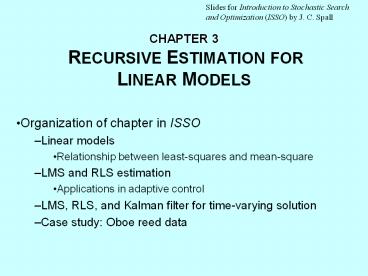CHAPTER 3 RECURSIVE ESTIMATION FOR LINEAR MODELS - PowerPoint PPT Presentation
Title:
CHAPTER 3 RECURSIVE ESTIMATION FOR LINEAR MODELS
Description:
Applications in adaptive control. LMS, RLS, and Kalman filter for time-varying solution ... an ill wind that nobody blows good. ... – PowerPoint PPT presentation
Number of Views:438
Avg rating:3.0/5.0
Title: CHAPTER 3 RECURSIVE ESTIMATION FOR LINEAR MODELS
1
CHAPTER 3 RECURSIVE ESTIMATION FOR LINEAR MODELS
Slides for Introduction to Stochastic Search and
Optimization (ISSO) by J. C. Spall
- Organization of chapter in ISSO
- Linear models
- Relationship between least-squares and
mean-square - LMS and RLS estimation
- Applications in adaptive control
- LMS, RLS, and Kalman filter for time-varying
solution - Case study Oboe reed data
2
Basic Linear Model
- Consider estimation of vector ? in model that is
linear in ? - Model has classical linear form
- where zk is kth measurement, hk is corresponding
design vector, and vk is unknown noise value - Model used extensively in control, statistics,
signal processing, etc. - Many estimation/optimization criteria based on
squared-error-type loss functions - Leads to criteria that are quadratic in ?
- Unique (global) estimate ?
3
Least-Squares Estimation
- Most common method for estimating ? in linear
model is by method of least squares - Criterion (loss function) has form
- where Zn z1, z2 ,, znT and Hn is n ? p
concatenated matrix of hkT row vectors - Classical batch least-squares estimate is
- Popular recursive estimates (LMS, RLS, Kalman
filter) may be derived from batch estimate
4
Geometric Interpretation of Least-Squares
Estimate when p 2 and n 3
5
Recursive Estimation
- Batch form not convenient in many applications
- E.g., data arrive over time and want easy way
to update estimate at time k to estimate at time
k1 - Least-mean-squares (LMS) method is very popular
recursive method - Stochastic analogue of steepest descent algorithm
- LMS recursion
- Convergence theory based on stochastic
approximation (e.g., Ljung, et al., 1992
Gerencsér, 1995) - Less rigorous theory based on connections to
steepest descent (ignores noise) (Widrow and
Stearns, 1985 Haykin, 1996)
6
LMS in Closed-Loop Control
- Suppose process is modeled according to
autoregressive (AR) form - where xk represents state, ? and ?i are unknown
parameters, uk is control, and wk is noise - Let target (desired) value for xk be dk
- Optimal control law known (minimizes mean-square
tracking error) - Certainty equivalence principle justifies
substitution of parameter estimates for unknown
true parameters - LMS used to estimate ? and ?i in closed-loop mode
7
LMS in Closed-Loop Control for First-Order AR
Model
8
Recursive Least Squares (RLS)
- Alternative to LMS is RLS
- Recall LMS is stochastic analogue of steepest
descent (first order method) - RLS is stochastic analogue of Newton-Raphson
(second order method) ? faster convergence than
LMS in practice - RLS algorithm (2 recursions)
- Need P0 and to initialize RLS recursions
9
Recursive Methods for Estimation of Time-Varying
Parameters
- It is common to have the underlying true ? evolve
in time (e.g., target tracking, adaptive control,
sequential experimental design, etc.) - Time-varying parameters implies ? replaced with
?k - Consider modified linear model
- Prototype recursive form for estimating ?k is
- where choice of Ak and ?k depends on specific
algorithm
10
Three Important Algorithms for Estimation of
Time-Varying Parameters
- LMS
- Goal is to minimize instantaneous squared-error
criteria across iterations - General form for evolution of true parameters ?k
- RLS
- Goal is to minimize weighted sum of squared
errors - Sum criterion creates inertia not present in
LMS - General form for evolution of ?k
- Kalman filter
- Minimizes instantaneous squared-error criteria
- Requires precise statistical description of
evolution of ?k via state-space model - Details for above algorithms in terms of
prototype algorithm (previous slide) are in
Section 3.3 of ISSO
11
Case Study LMS and RLS with Oboe Reed Data
- an ill wind that nobody blows good.
- Comedian Danny Kaye in speaking of the oboe in
the The Secret Life of Walter Mitty (1947) - Section 3.4 of ISSO reports on linear and
curvilinear models for predicting quality of oboe
reeds - Linear model has 7 parameters curvilinear has 4
parameters - This study compares LMS and RLS with batch
least-squares estimates - 160 data points for fitting models (reeddata-fit
) 80 (independent) data points for testing
models (reeddata-test) - reeddata-fit and reeddata-test data sets
available from ISSO Web site
12
Oboe with Attached Reed
13
Comparison of Fitting Results for reeddata-fit
and reeddata-test
- To test similarity of fit and test data sets,
performed model fitting using test data set - This comparison is for checking consistency of
the two data sets not for checking accuracy of
LMS or RLS estimates - Compared model fits for parameters in
- Basic linear model (eqn. (3.25) in ISSO) (p 7)
- Curvilinear model (eqn. (3.26) in ISSO) (p 4)
- Results on next slide for basic linear model
14
Comparison of Batch Parameter Estimates for Basic
Linear Model. Approximate 95 Confidence
Intervals Shown in ,
15
Comparison of Batch and RLS with Oboe Reed Data
- Compared batch and RLS using 160 data points in
reeddata-fit and 80 data points for testing
models in reeddata-test - Two slides to follow present results
- First slide compares parameter estimates in pure
linear model - Second slide compares prediction errors for
linear and curvilinear models
16
Batch and RLS Parameter Estimates for Basic
Linear Model (Data from reeddata-fit )
17
Mean and Median Absolute Prediction Errors for
the Linear and Curvilinear Models (Model fits
from reeddata-fit Prediction Errors from
reeddata-test)































